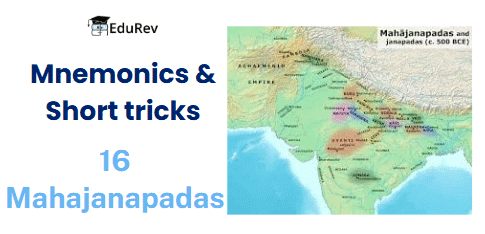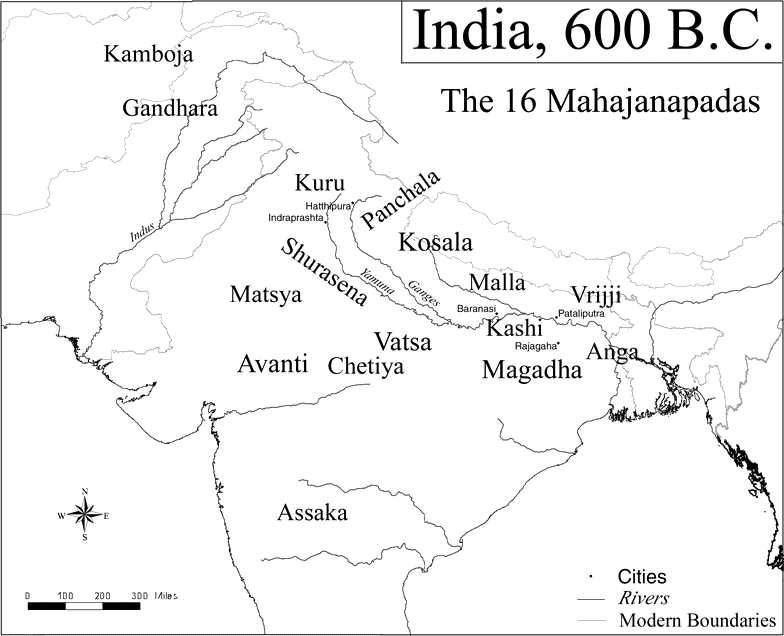UPSC Exam > UPSC Notes > History for UPSC CSE > Mnemonics: Mahajanapada Period
Mnemonics: Mahajanapada Period | History for UPSC CSE PDF Download
This guide will help you remember important information about the Mahajanapadas in a fun and easy way. Inside, you’ll find creative mnemonics—memory tricks—that will make it easier for you to recall 16 Mahajanapadas.

Whether you're studying history or simply enhancing your understanding of ancient India, these mnemonics will serve as valuable tools to boost your memory. Use them alongside your regular study routine to improve retention and recall of key Mahajanapada names and concepts.

Part 1 - First 8 Mahajanapadas
Mnemonic: King Keeps All Men Very Motivated, Chasing Victories
Mnemonic Explanation:
- King: Kasi (Known for Varanasi's religious importance)
- Keeps: Kosala (Associated with Ayodhya, Lord Rama's birthplace)
- All: Anga (Located near present-day Bihar and Bengal)
- Men: Magadha (A powerful kingdom in early Indian history)
- Very: Vajji (A confederation known for its republican government)
- Motivated: Malla (Located in present-day Nepal and Uttar Pradesh)
- Chasing: Chedi/Cheti (Mentioned in Vedic texts)
- Victories: Vatsa (Located in modern-day Uttar Pradesh, ruled by King Udayana)
Part 2 - Last 8 Mahajanapadas
Mnemonic: KaPu Makes Soft Aloo And Gajar Ka halwa!
Mnemonic Explanation:
- Ka: Kuru (Famous for its battles in the Mahabharata)
- Pu: Panchala (Known for the story of Draupadi's birth)
- Makes: Matsya (Located in present-day Rajasthan)
- Soft: Surasena/Shurasena (Known for its association with Lord Krishna)
- Aloo: Assaka (A kingdom in the Deccan region)
- And: Avanti (Known for the city of Ujjain and its historical significance)
- Gajar: Gandhara (Located in the northwest, known for its culture and trade)
- Ka halwa: Kamboja (Located in the region of modern-day Afghanistan, known for its warrior culture)
The document Mnemonics: Mahajanapada Period | History for UPSC CSE is a part of the UPSC Course History for UPSC CSE.
All you need of UPSC at this link: UPSC
|
210 videos|839 docs|219 tests
|
FAQs on Mnemonics: Mahajanapada Period - History for UPSC CSE
| 1. What were the main features of the first 8 Mahajanapadas? |  |
Ans. The first 8 Mahajanapadas were characterized by their political organization, economic activities, and geographical locations. They included notable kingdoms such as Magadha, Kosala, and Vatsa. These regions were known for their agricultural productivity, trade routes, and urban centers. The political systems varied from monarchies to oligarchies, and they played a significant role in the rise of Buddhism and Jainism during this period.
| 2. Can you list the last 8 Mahajanapadas and their significance? |  |
Ans. The last 8 Mahajanapadas included regions like Avanti, Gandhara, and Kamboja. Each of these Mahajanapadas had its own unique cultural and economic contributions. For instance, Avanti was known for its wealth and trade, while Gandhara was famous for its art and architecture. Their significance lies in how they contributed to the political, social, and cultural landscape of ancient India, paving the way for future dynasties.
| 3. How did the Mahajanapada period influence later Indian history? |  |
Ans. The Mahajanapada period laid the foundation for the rise of large empires in India, such as the Maurya and Gupta Empires. The political and economic structures established during this time influenced governance, trade practices, and cultural exchanges. The emergence of Buddhism and Jainism during this era also had a lasting impact on Indian philosophy and religious practices.
| 4. What are some effective mnemonics to remember the Mahajanapadas? |  |
Ans. Some effective mnemonics to remember the Mahajanapadas include creating acronyms or phrases using the first letters of each Mahajanapada. For example, for the first 8 Mahajanapadas, you could use a phrase like "Mighty Kings Vow To Conquer," where each word represents a Mahajanapada. Alternatively, visual aids or songs can also be helpful in memorizing these historical names.
| 5. Why is the study of Mahajanapadas important for understanding ancient Indian civilization? |  |
Ans. The study of Mahajanapadas is crucial for understanding ancient Indian civilization as it highlights the political, economic, and cultural dynamics of the time. It reveals how various regions interacted, traded, and influenced each other, contributing to the rich tapestry of Indian history. Additionally, understanding this period helps in comprehending the origins of major religions, social structures, and governance that shaped the future of India.
Related Searches





















